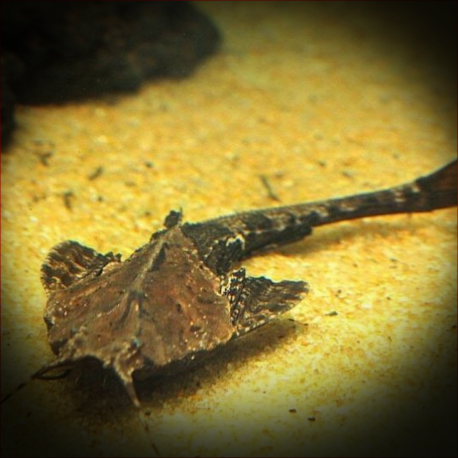More info
Datasheet
| Minimum Tank Size | 71 litres / 18.76 US gallons |
| Maximum Size | 15.0cm / 5.91inches |
| Temperature | 20°C / 68.00°F - 27°C / 80.60°F |
| Hardness | 2-20ºdH |
| pH | 5.8-7.8 |
General Description
Bunocephalus coracoideus, commonly known as the Banjo Catfish, is the most frequently encountered member of the Bunocephalus genus in aquarium trade. Resembling a fallen leaf, it boasts a unique appearance that aids in camouflage. This sedentary species, native to Bolivia, Peru, and Brazil, typically resides in forest streams and lakes with abundant leaf litter. With a maximum size of 15.0cm, these catfish are best suited for enthusiasts rather than general community tanks due to their nocturnal and inactive behavior.
Aquarium Setup
For optimal care, the Banjo Catfish necessitates a tank size of at least 71 liters with hiding spots and subdued lighting. A suitable setup includes sand substrate, rocks, and bogwood for shelter. Adding dried oak or beech leaves not only enhances the tank's aesthetics but also helps the catfish blend in naturally. Water conditions should be maintained within a pH range of 5.8-7.8, a hardness of 2-20 degrees dH, and a temperature range of 20-27°C (see table for details).
Behaviour
Known for its docile nature, the Banjo Catfish is compatible with various tankmates, making it suitable for community aquariums. It exhibits no aggression towards conspecifics and can be kept singly or in groups. Despite being inactive during the day, this species becomes more active and ventures out under the cover of darkness, showcasing its unique swimming behavior propelled by water intake through the mouth.
Feeding and Diet
Although not picky eaters, Banjo Catfish can be challenging to feed due to their sedentary lifestyle. They thrive on live and frozen foods like bloodworms and earthworms, as well as sinking dried foods. Feeding them after lights out ensures they receive an adequate share of food.
Reproduction & Dimorphism
Reproduction in captivity is rare but feasible with a group of mature specimens. During spawning, which occurs at night, eggs are laid on the substrate. It is crucial to transfer the eggs to a separate tank to prevent them from being eaten by the adults. Identifying sexual dimorphism is tricky, but adult females are typically larger and have a rounder belly compared to males.
Habitat and Distribution
Banjo Catfish are primarily found in the forest streams, lakes, and ponds of Bolivia, Peru, and Brazil. They inhabit areas abundant in leaf litter, fallen branches, and similar debris. This natural habitat provides the necessary cover and camouflage for these catfish to thrive in the wild.

